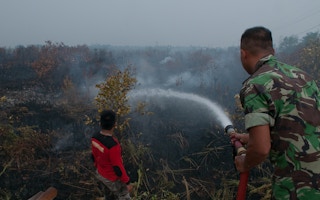Like their compatriots across Indonesia, a group of residents in the Bornean city of Pontianak celebrated the country’s Independence Day on Aug. 17 with a flag-raising ceremony.
But for them, the simple act of hoisting the Red-and-White was a physically taxing endeavor, thanks to the toxic haze billowing from a smoldering plot of peatland nearby. The sound of wood crackling in the fire could be heard as the participants, their surgical masks doing nothing to keep the smoke out of their eyes, stood through the ceremony. When it was over, they returned to what they were doing: working to put out the pockets of fire flaring up from the mulch-rich peat soil.
Beni Sulastiyo is one of the leaders of this group of residents of Pontianak, the capital of the province of West Kalimantan, who have banded together as volunteer firefighters. He says they see the fire problem as something that the whole community, and not just the government, needs to address.
“This should be a shared responsibility for everyone. As members of the community, we’re on the same page in helping the government,” he says.
Ateng Tanjaya is nearly 70, and has worked as a volunteer firefighter in Pontianak for more than 40 years. The work is often thankless, he says, and the hardships legion: lack of hoses and fire equipment, shortage of water, and scant funding and logistical support.
For these volunteers, the fires won’t end any time soon. The dry season is kicking in, and after a relatively haze-free 2016 and 2017, conditions this year look ripe for the fires to grow out of control.
“
The work that the BRG has done on the ground hasn’t had a significant impact over the short term. The fact is that fires are still happening in these priority areas during the dry season.
Anton P. Widjaya, director, Walhi’s West Kalimantan chapter
Deadly heat
There have been nearly 2,200 fire hot spots recorded across Indonesia between Jan. 1 and Aug. 14, according to the Indonesian Forum for the Environment (Walhi), the country’s leading green NGO. West Kalimantan recorded the highest number of any province, at 779.
At least four people are confirmed to have died in the fires in the province. The latest victim, a 69-year-old farmer in Sintang district, reportedly died while trying to put out a blaze on his land on Aug. 19. Six days earlier, a family of three in Melawi district died in their burning house.
In Pontianak, the haze has sometimes been so thick that visibility is limited to 5 meters (16 feet). Flights into and out of the city’s Supadio International Airport are under constant threat of being cancelled or diverted whenever visibility drops below 1,000 meters (3,300 feet). Elsewhere across the province, schools were ordered shut on Aug. 20 when the haze worsened.
Satellite imagery from the Global Forest Watch platform shows smoke plumes in the most affected areas, including Pontianak and Ketapang district.
Air quality in Pontianak has been declining in recent weeks, according to data from the national weather agency, the BMKG, uploaded to the global monitoring platform IQAIR Air Visual. This has been marked by an increase in the concentration of tiny carcinogenic particles known as PM2.5 in the air.
These particles are small enough to enter the bloodstream; long-term exposure to them can cause acute respiratory infections and cardiovascular disease.
PM2.5 concentrations crossed into dangerous territory on Aug. 19 and 23, when the average daily levels registered at 73.5 and 79 micrograms per cubic meter, respectively — triple the World Health Organization’s guideline level of 25 micrograms per cubic meter in a 24-hour period.
‘Shoot on sight’
It’s a similar story across the Karimata Strait from Borneo, on the island of Sumatra. Norton Marbun, a resident of Rantau Benuang village in Riau province, says the fires there began on Aug. 14, razing the villagers’ oil palm farms.
He was out in the fields helping fight the flames, he says, and almost didn’t notice the fire closing in on his house, where his wife and children were sheltering. He rushed back to find the house, which he’d just finished building three months earlier after 11 years of saving up, filled with smoke. His wife didn’t want to leave — the house was all they had, she said — and Norton says he had to drag her and the kids out as the flames bore down.
They were barely out when a gas canister exploded inside the house. “If I’d been even 10 minutes late, maybe my family would have been skeletons inside the house,” Norton says.
They lost everything with their house, including two motorcycles. The family has since moved to a neighboring village. But even there they can’t escape from the haze.
“Now my children are having difficulty breathing due to the haze,” Norton says.
As growing forest and peat fires fan the haze across Riau, the military has been roped into the effort to fight the fires. A local military commander says nearly all the fires are set deliberately, and has issued a shoot-on-sight order for anyone caught doing so. (It’s not clear how this would be justified; Indonesian law has clear statutes proscribing extrajudicial shootings by law enforcement.)
This story was published with permission from Mongabay.com. Read the full story.

















